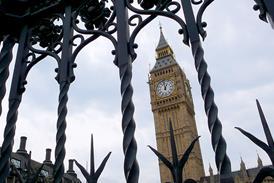There is plenty of evidence to suggest that closing small accident and emergency departments is not necessarily the solution to the problems facing the sector, says Robert Royce
While at the King’s Fund as a visiting fellow I worked with Nigel Edwards on a report for South of England strategic health authority on differences in unscheduled care performance between local health economies. One message in that report is that “the data does not explain the problem”. Variation in performance was not easily explainable by the particular characteristics of either providers, or local health economies.

In short, it is often not very clear why some places are struggling much more than others.
This article highlights some performance statistics for 2012-13 and while the data will still not “explain the problem”, I hope it gives cause for reflection as to the potential risks of closing small accident and emergency departments.
Rating performance
Within the overall downward trend for breaching the four-hour treatment target in 2012-13 are many variations between trusts and areas. The 10 worst performing trusts in 2012-13 for breaches of type-1 patients were:
| Worst performing trusts for type 1 A&E breaches | Patients seen in four hours |
|---|---|
| Milton Keynes | 84.70% |
| Barking, Havering and Redbridge | 86.22% |
| North West London Hospitals | 87.70% |
| University Hospitals Coventry and Warwickshire | 88.25% |
| Portsmouth Hospitals | 88.25% |
| Burton Hospitals | 88.60% |
| University Hospitals of Leicester | 88.67% |
| North Bristol | 88.72% |
| Croydon Healthcare | 89.42% |
| University Hospital of North Staffordshire | 89.47% |
None of these trusts are very small, while some of them deal with very large numbers of A&E attendances. They are predominantly in Greater London and the Midlands, which mirrors a general trend of trusts in the North having a better four-hour waiting time performance.
Why should this be so? There are many theories: smaller population growth and a less “dynamic” population mix; a more stable workforce; the quality of general practice; better relationships with local government; better run organisations; the distribution and size of hospitals. The list is long… but essentially remains conjecture.
Research needed
For a subject that generates many news headlines and is one of the dominant themes on the managerial agenda, surprisingly little research has been undertaken on the dynamics of A&E attendance and hospital admission.
‘Struggling trusts are rather like Tolstoy’s unhappy families − that is “unhappy in their own way”’
Research should not be confused with either newsprint or advisory publications. If you don’t believe me search the journals for UK articles that provide breakdowns of who comes to A&E, with what complaint, who treats them, and who could have been seen elsewhere or not admitted. Given the above, it will take a surprisingly short time to read.
Retuning to the data, the tables below look at the 2012-13 performance of the 10 largest trusts (by A&E attendance) in England versus the 10 smallest. Collectively the smallest outperformed the largest by 2.32 per cent and had a better performance than England’s average (94.64 versus 93.72) − the 10 largest averaged 92.42 per cent. These are not huge differences in performance and we need to be clear that small is not necessarily good and or big bad.
| Ten largest trusts (by type 1 A&E attendance) 2012-13 | Patients seen in four hours (%) |
|---|---|
Barts Health | 93.87 |
| Pennine Acute Hospitals | 95.25 |
| Heart of England FT | 91.12 |
| Barking, Havering and Redbridge | 86.22 |
| Mid Yorkshire Hospitals | 96.07 |
| Leeds Teaching Hospitals | 92.55 |
| Central Manchester Univ Hospitals FT | 93.30 |
| South London Healthcare Trust | 91.85 |
| Sandwell and West Birmingham Hospitals | 90.85 |
| Nottingham University Hospitals | 93.15 |
Average | 92.42 |
| NHS England Average | 93.72 |
| Difference | -1.3 |
| Ten smallest trusts (by type 1 A&E attendance) 2012-13 | Patients seen in four hours (%) |
|---|---|
| Hinchingbrooke Health Care | 97.62 |
| Northern Devon Healthcare | 94.42 |
| Dorset County Hospital FT | 96.52 |
| Salisbury FT | 96.92 |
| Ealing Hospital | 93.15 |
| Isle of Wight | 92.37 |
| Harrogate and District FT | 96.45 |
| Southport and Ormskirk Hospital | 90.25 |
| Yeovil District Hospital FT | 95.07 |
| Wye Valley | 93.65 |
Average | 94.64 |
| NHS England average | 93.72 |
| Difference | 0.92 |
| Difference from 10 largest trusts | 2.22 |
There are small trusts that are struggling, and if one widens the scope to cover the top 20 trusts by volume against the smallest 20 the gap narrows to just over 1 per cent. The truth is that struggling trusts (and local health economies) are rather like Tolstoy’s unhappy families − that is “unhappy in their own way”.
Data complexity
What I am saying is there are some particular challenges with big trusts that should be worrying those pushing for them rather more than it seems to. Looking at the top 10 trusts by A&E volume, there is a disproportionately large number of non-foundation trusts and some record extremely large deficits.
Some of these also have poor four-hour performance, although anyone looking to make a complete association between financial performance and four-hour breaches will have to account for Mid Yorkshire, which combined one of the highest projected deficits in 2012-13 with good four-hour performance.
Mid Yorkshire, like many of the other organisations in the top 10, operates more than one A&E. This creates further complexity to anyone trying to draw conclusions from public data. There are 34 trusts running two or more A&Es in England. Their performance is aggregated and can hide significant variation between units.
One might guess that in many cases there is a plan to shut down or redesignate the smaller units and consolidate on to the larger site as a means of delivering 24-hour consultant cover and financial balance. Unfortunately, it is often the case that the smaller units’ performance is bailing out the larger one.
Blocked access
If you concentrate unscheduled care work to fewer hospitals you should recognise that normal variation in patient volumes will throw up days, and worse still periods, of very high demand.
‘When big hospitals go wrong they go wrong in a spectacular way’
If you run such hospitals with at least 90 per cent occupancy, which appears to have become the norm in much of the NHS, you will inevitably get times when the hospital will seize up and the department becomes unsafe. In relation to this, it should be recognised that although having people attend A&E who could be cared for elsewhere is typically viewed by the NHS as irritating (and if presenting in enough numbers can lead to departmental overload) such patients are not the main cause of A&Es “falling over”.
The main problem is − and always has been − “access block”. That is: patients who have been assessed, who have been deemed to require admission, but can’t go to a bed because there are none available. Inadequate capacity and responsiveness across the health and social care system will increase the frequency, severity and duration of these crises.
Moreover when big hospitals go wrong they go wrong in a spectacular way. If you have downgraded other local hospitals and A&E departments there may literally be nowhere else to go. Such hospitals become too big operationally to fail − although this is no guarantee that failure will not occur.
A useful example
In this regard the experience of Barking, Havering and Redbridge University Hospitals Trust may be instructive; combining one of the largest A&E volumes in England with the second worst four-hour performance.
Moreover, there is a significant difference in performance at its two hospitals. The performance at King George Hospital from 25 March to 21 April was 96.1 per cent and for Queen’s Hospital it was only 80.3 per cent.
The Care Quality Commission, following an inspection in January proposed a cap be put on the Queen’s A&E as a safety measure. To date that cap has not been enforced, but nor has the pressure eased. Perhaps because a cap is extremely difficult to achieve practically with other “local” providers considering themselves in little better position than Barking, Havering and Redbridge and therefore extremely reluctant to take additional patients.
It is unsurprising when those opposed to reconfiguration of services ask pointedly what would happen when the likes of King George Hospital are no longer around. Seemingly the data does not explain the problem, but nor does it offer much comfort to those who wish to convince the public and clinicians that fewer A&Es are the way forward.
Dr Robert Royce is an independent healthcare consultant, robertgroyce@live.com



























6 Readers' comments